-

新人教版高中英语选修2Unit 4 Using langauge-Listening教学设计
The theme of the listening section is " talking about scenery and culture along a journey."The part is designed to further lead the students to understand Canadian natural geography and social environment, and integrated into the cultural contrast by mentioning the long train journey from Beijing to Moscow routes. On this basis, the part activates students related travel experience, lets the student serial dialogue, guides the student to explore further the pleasure and meaning of the long journey, and Chinese and foreign cultural comparison.The part also provides a framework for the continuation of the dialogue, which is designed to provide a framework for students to successfully complete their oral expressions, and to incorporate an important trading strategy to end the dialogue naturally.1. Help students to understand and master some common English idioms in the context, and experience the expression effect of English idioms.2. Guide the students to understand the identity of different people in the listening context, and finish the dialogue according to their own experience.3. Instruct the students to use appropriate language to express surprise and curiosity about space and place in the dialogue, and master the oral strategy of ending the dialogue naturally.1. Instruct students to grasp the key information and important details of the dialogue.2. Instruct students to conduct a similar talk on the relevant topic.

新人教版高中英语选修2Unit 5 Learning about Language教学设计
The purpose of this section of vocabulary exercises is to consolidate the key words in the first part of the reading text, let the students write the words according to the English definition, and focus on the detection of the meaning and spelling of the new words. The teaching design includes use English definition to explain words, which is conducive to improving students' interest in vocabulary learning, cultivating their sense of English language and thinking in English, and making students willing to use this method to better grasp the meaning of words, expand their vocabulary, and improve their ability of vocabulary application. Besides, the design offers more context including sentences and short passage for students to practice words flexibly.1. Guide students to understand and consolidate the meaning and usage of the vocabulary in the context, 2. Guide the students to use the unit topic vocabulary in a richer context3. Let the students sort out and accumulate the accumulated vocabulary, establishes the semantic connection between the vocabulary,4. Enable students to understand and master the vocabulary more effectivelyGuiding the Ss to use unit topic words and the sentence patterns in a richer context.Step1: Read the passage about chemical burns and fill in the blanks with the correct forms of the words in the box.

新人教版高中英语选修2Unit 5 Reading and thinking教学设计
The theme of this activity is to learn the first aid knowledge of burns. Burns is common in life, but there are some misunderstandings in manual treatment. This activity provides students with correct first aid methods, so as not to take them for granted in an emergency. This section guides students to analyze the causes of scald and help students avoid such things. From the perspective of text structure and collaborative features, the text is expository. Expository, with explanation as the main way of expression, transmits knowledge and information to readers by analyzing concepts and elaborating examples. This text arranges the information in logical order, clearly presents three parts of the content through the subtitle, accurately describes the causes, types, characteristics and first aid measures of burns, and some paragraphs use topic sentences to summarize the main idea, and the level is very clear.1. Guide students to understand the causes, types, characteristics and first aid methods of burns, through reading2. Enhance students’ ability to deal withburnss and their awareness of burns prevention3. Enable students to improve the ability to judge the types of texts accurately and to master the characteristics and writing techniques of expository texts.Guide students to understand the causes, types, characteristics and first aid methods of burns, through readingStep1: Lead in by discussing the related topic:1. What first-aid techniques do you know of ?CPR; mouth to mouth artificial respiration; the Heimlich Manoeuvre

新人教版高中英语选修2Unit 5 Using langauge-Listening教学设计
The theme of this section is to learn how to make emergency calls. Students should learn how to make emergency calls not only in China, but also in foreign countries in English, so that they can be prepared for future situations outside the home.The emergency telephone number is a vital hotline, which should be the most clear, rapid and effective communication with the acute operator.This section helps students to understand the emergency calls in some countries and the precautions for making emergency calls. Through the study of this section, students can accumulate common expressions and sentence patterns in this context. 1.Help students accumulate emergency telephone numbers in different countries and learn more about first aid2.Guide the students to understand the contents and instructions of the telephone, grasp the characteristics of the emergency telephone and the requirements of the emergency telephone.3.Guide students to understand the first aid instructions of the operators.4.Enable Ss to make simulated emergency calls with their partners in the language they have learned1. Instruct students to grasp the key information and important details of the dialogue.2. Instruct students to conduct a similar talk on the relevant topic.Step1:Look and discuss:Match the pictures below to the medical emergencies, and then discuss the questions in groups.

新人教版高中英语选修3Unit 2 Healthy Lifestyle教案
Activity 4: Figuring out the structure and the writing purpose 本活动为实现课时目标2。 1.Read Paragraph 6 and think about its main idea and the writer’s writing purpose. Q1: If you were the author, how would you end your article? “For young people, there is plenty of time to change bad habits. However, there is no “magic pill” or delete button that will help you; you have to think about your bad habits and decide on some changes. You have the power to build a happy and healthy life full of good habits!” Q2: What is Paragraph 6 mainly about? (Possible answer: to appeal to young people including teenagers to change bad habits and live a happy and healthy life.) 2.Think about the writer’s writing purpose and share opinions. Q1: What is the writing purpose? Work in pairs and figure it out. (Possible answer: On the one hand, the passage is written to help teenagers change their bad habits and live a healthy lifestyle. On the other hand, it provides us with a scientific way to identify and analyse our problems objectively, thus strengthening our resolve to tackle the seemingly common yet tough problems in our lives.) 【设计意图】 步骤1旨在预测和验证文章最后一段主要内容,梳理完整的语篇结构,步骤2旨在思考和讨论作者的写作目的。教师也可根据学生课堂反应情况融入对语篇人称多次转换的思考。

新人教版高中英语选修4Unit 2 Iconic Attractions教案
帮助学生通过讨论与对主题的提升,反思自己的旅游方式,以便做出更优化的安排,在今后的旅程中有更多的收益。 Activity 2: Further discussion of the 6 elements above and supplement of more background knowledge 本活动为实现课时教学目标2。 1.Target Q: The writer’s clear target of traveling, meeting the people and experiencing the culture, is closely related to his major in social studies. Then what is social studies? Social studies is a part of a school or college curriculum concerned with the study of social relationships and the functioning of society and usually made up of courses in history, government, economics, civics, sociology, geography, and anthropology. (Dictionary by Merriam-Webster) Reflection: When you go out to travel, what targets do you usually have in mind? 2.Research Q: Suppose you are traveling to Hangzhou during the school holidays, how will you do research on the city? (surf the internet, read books or travel brochures, consult friends, ...) What information will you be interested to know? (location, iconic sites, local cuisines, interesting customs, shopping malls ...) 3.Abandonment To make the most of time, we have to learn to abandon so that we can accomplish our plan. What will you be interested in doing if you go to Hangzhou if you have a week’s time? What if you only have 2 days? 4~5. Venturing & Experiencing Q: What did he venture to do during the trip? What new experiences did he have? In Sydney: attend his first open-air barbecue, enjoy many different but yummy meals In Catherine: observe the life and customs of the aborigines appreciate their music & try the musical instruments: the didgeridoo
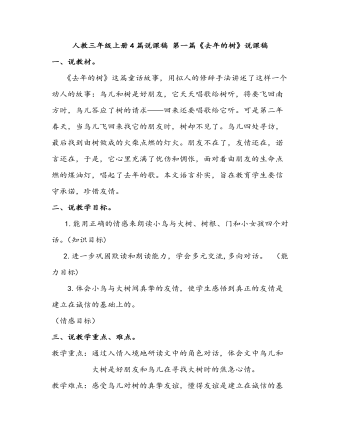
人教版三年级上册语文说课稿
二、说教学目标。 1.能用正确的情感来朗读小鸟与大树、树根、门和小女孩四个对话。(知识目标) 2.进一步巩固默读和朗读能力,学会多元交流,多向对话。 (能力目标) 3.体会小鸟与大树间真挚的友情,使学生感悟到真正的友情是建立在诚信的基础上的。
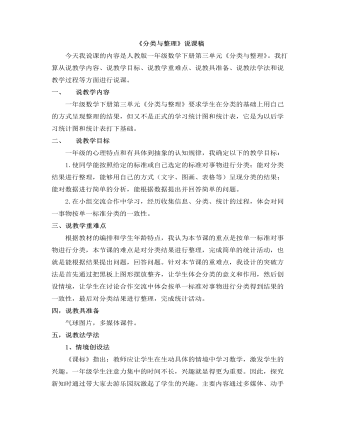
小学数学人教版一年级下册《分类与整理》说课稿
今天我说课的内容是人教版一年级数学下册第三单元《分类与整理》。我打算从说教学内容、说教学目标、说教学重难点、说教具准备、说教法学法和说教学过程等方面进行说课。一、 说教学内容一年级数学下册第三单元《分类与整理》要求学生在分类的基础上用自己的方式呈现整理的结果,但又不是正式的学习统计图和统计表,它是为以后学习统计图和统计表打下基础。二、 说教学目标一年级的心理特点和有具体到抽象的认知规律,我确定以下的教学目标:1.使同学能按照给定的标准或自己选定的标准对事物进行分类;能对分类结果进行整理,能够用自己的方式(文字、图画、表格等)呈现分类的结果;能对数据进行简单的分析,能根据数据提出并回答简单的问题。2.在小组交流合作中学习,经历收集信息、分类、统计的过程,体会对同一事物按单一标准分类的一致性。三、说教学重难点根据教材的编排和学生年龄特点,我认为本节课的重点是按单一标准对事物进行分类,本节课的难点是对分类结果进行整理,完成简单的统计活动,也就是能根据结果提出问题,回答问题。针对本节课的重难点,我设计的突破方法是首先通过把黑板上图形摆放整齐,让学生体会分类的意义和作用,然后创设情境,让学生在讨论合作交流中体会按单一标准对事物进行分类得到结果的一致性,最后对分类结果进行整理,完成统计活动。

小学数学人教版六年级下册 《整理和复习》说课稿
一、说教材:1、教学内容:我说课的教学内容是整理和复习2、教学地位:本课是在学习了所有内容的基础上进行教学的,同时又是前面学习的总结。3、教学目标:(1)使学生结合具体的情境,探索并发现(或理解并掌握)所有所学的内容,会运用所学的知识解决简单的实际问题。(2)使学生主动经历自主探索、合作交流的过程,培养观察、比较、分析、归纳、概括等思维能力。(3)使学生在探索新知的过程中, 体会数学与生活的联系,获得成功的体验,增强学好数学的自信心。4、教学重点、难点:为了使学生能比较顺利地达到教学目标,我确定了本课的重点和难点,教学重点和难点是熟练并掌握所学的所有内容。
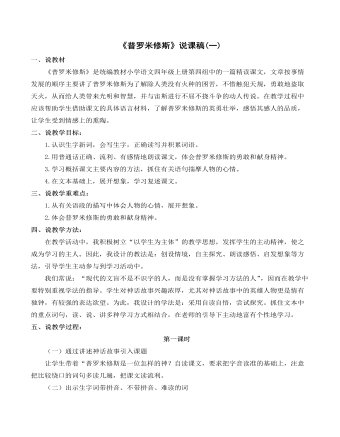
(新)部编人教版四年级上册《普罗米修斯》说课稿(一)
四、说教学方法: 在教学活动中,我积极树立“以学生为主体”的教学思想,发挥学生的主动精神,使之成为学习的主人。因此,我设计的教法是:创设情境,自主探究、朗读感悟、启发想象等方法,引导学生主动参与到学习活动中。 我们常说:“现代的文盲不是不识字的人,而是没有掌握学习方法的人”,因而在教学中要特别重视学法的指导。学生对神话故事兴趣浓厚,尤其对神话故事中的英雄人物更是情有独钟,有较强的表达欲望。为此,我设计的学法是:采用自读自悟,尝试探究。抓住文本中的重点词句,读、说、讲多种学习方式相结合,在老师的引导下主动地富有个性地学习。
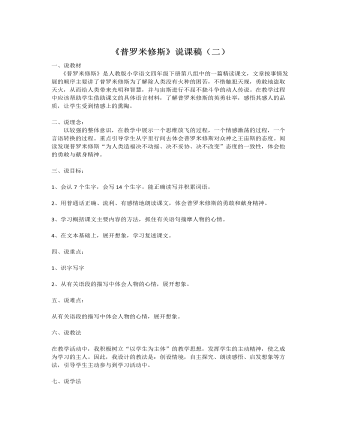
(新)部编人教版四年级上册《 普罗米修斯》说课稿(二)
第二课时 (一)、导入:中国古代神话传说中的女娲赋予人类生命,又为了人类幸福,历尽辛苦。而在古希腊神话故事中,也有一位带给人类幸福和光明的神,还记得他是谁吗?开启神话故事的窗口,激发阅读期待,激起学生对神话故事一种美的向往之情。 (二)、复习生词,学写生字通过分层设计复习词语,既使学生再现所学知识,又为学习新知识扫除障碍,重点强调“脏”是个多音字。指导书写:重点指导:“膝”“焰”“败”让学生整体观察字的特点,找出每个字的书写特点,力求将字写正确,写美观,同时注重书写反馈。(三)、直入重点,感悟“英雄”形象1采用大问题情境下的板块式教学模式,让学生默读课文,思考:你从哪些词句中感受到了普罗米修斯是一位英雄的?找一找,画一画,把感受写一写。然后检测学生对课文内容的理解,之后对本课进行深入的学习。
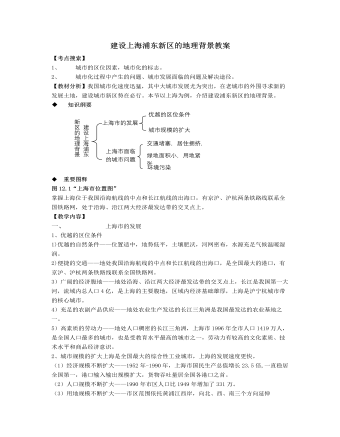
人教版高中地理选修2建设上海浦东新区的地理背景教案
2、上海是全国最大的商业中心,上海港是全国最大的港口。商业中心区位选择因素与港口的区位选择因素的共性条件是( )A、自然地理条件B、经济地理条件C、地理位置D、经济腹地3、中国政府宣布开发上海浦东的时间是( )A、1978年B、1985年C、1989年D、1990年4、有关上海优越区位条件的叙述,错误的是( )A、长江三角洲可提供充足的农副产品B、是全国最大的交通枢纽C、是我国最大城市带的核心城市D、是我国面积最大的直辖市5、目前上海市面临的最主要的人口问题是( )A、人口老龄化,青壮年赡养照顾众多老人负担过重B、卫星城镇人口比重大C、人口基数大,自然增长率高D、人口年龄构成轻,生育高峰压力大6、城市问题产生的主要原因是( )A、城市规模扩大B、城市基础设施相对滞后C、城市管理混乱D、城市人口规模和经济规模的迅速扩大7、下列可反映上海市的城市问题的是( )A、上海市区人均道路面积略高于北京市区B、上海市沙尘暴天气多发C、上海市许多家庭三代人同室居住D、上海市人均绿地面积稍高于重庆

人教版高中地理选修2浦东新区的规划和开发教案
1、图12.5“浦东新区的规划图”首先了解浦东新区的位置,浦东新区位于黄浦江东部,东临东海,北濒长江,面积广阔,地形平坦,和上海市繁华的外滩和南京路只有一江之隔;其次要了解城市规划的功能分区。2、图12.6“浦东新区图”图中可见已建成陆家嘴、张江、金桥、外高桥、孙桥等功能分区,理解浦东作为现代化城市新区的格局已基本形成。3、图12.8“浦东新区的产业结构图(1997年)”读此图应该明确,浦东新区国民经济的主要支柱是工业,第二产业占62.1%,比重最小的是第一产业,仅占0.8%,为充分发挥浦东新区的龙头作用,今后该区应继续把第二产业放在首要位置,成为上海市高新技术产业和现代工业的基地。【教学内容】一、浦东新区的开发条件和作用建设城市新区是上海市发展的必然选择,建设新城区首先要选择合适的区域。
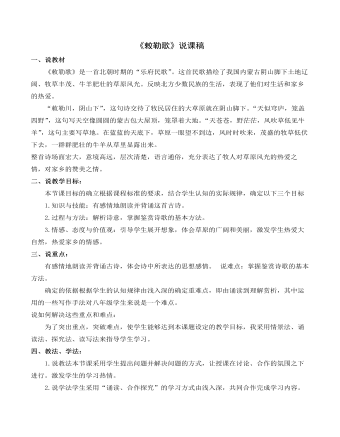
《敕勒歌》说课稿
动静结合。诗的前六句是静态的勾画;“风吹草低见牛羊”,这句是动态的描写。风吹草低,这一现啊,不仅现出了牛羊,还现出了草原的灵动。色彩的丰富,画面的灵动,使敕勒川变得更加美丽。
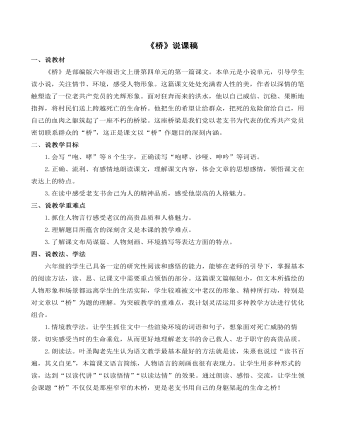
《桥》说课稿
一、说教学目标?1.会写“咆、哮”等8个生字,正确读写“咆哮、沙哑、呻吟”等词语。? 2.正确、流利、有感情地朗读课文,理解课文内容,体会文章的思想感情,领悟课文在表达上的特点。?3.在读中感受老支书舍己为人的精神品质,感受他崇高的人格魅力。??三、说教学重难点1.抓住人物言行感受老汉的高贵品质和人格魅力。2.理解题目所蕴含的深刻含义是本课的教学难点。3.了解课文布局谋篇、人物刻画、环境描写等表达方面的特点。?四、说教法、学法? 六年级的学生已具备一定的研究性阅读和感悟的能力,能够在老师的引导下,掌握基本的阅读方法,读、思、记课文中需要重点领悟的部分。这篇课文篇幅短小,但文本所描绘的人物形象和场景都远离学生的生活实际,学生较难被文中老汉的形象、精神所打动,特别是对文章以“桥”为题的理解。为突破教学的重难点,我计划灵活运用多种教学方法进行优化组合。?1.情境教学法。让学生抓住文中一些渲染环境的词语和句子,想象面对死亡威胁的情景,切实感受当时的生命垂危,从而更好地理解老支书的舍己救人、忠于职守的高贵品质。?2.朗读法。叶圣陶老先生认为语文教学最基本最好的方法就是读,朱熹也说过“读书百遍,其义自见”,本篇课文语言简练,人物语言的刻画也很有表现力。让学生用多种形式的读,达到“以读代讲”“以读悟情”“以读达情”的效果。通过朗读、感悟、交流,让学生领会课题“桥”不仅仅是那座窄窄的木桥,更是老支书用自己的身躯架起的生命之桥!
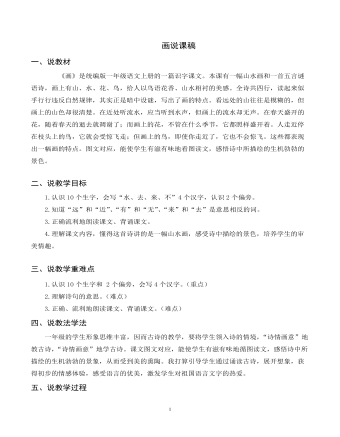
《画》说课稿
(坚持以读为本,让学生真正成为语文课堂的“读者”,通过自由读、分组读、指名读、教师引读等多形式的朗读,引导学生图文对照,感悟诗句的内容和表达的感情。另外,文中句子的节奏感很强,朗读时指导学生读出诗的节奏和韵味,在读中感悟、体会诗的读法,想象诗中描绘的美好画面,感受画的美,语言文字的美,激发学生对祖国语言文字的热爱之情。)
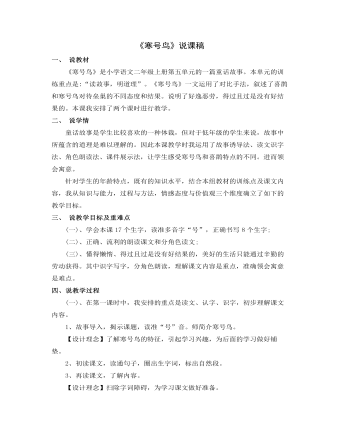
《寒号鸟》说课稿
(1)、学习第一自然段。学生自由读文,同桌相互说说知道了哪些信息?初步体会寒号鸟的懒惰。师板书:喜鹊 寒号鸟(2)、学习第二——四自然段。再次体会寒号鸟的懒惰。①、学生轻声读文,思考在什么时候,喜鹊和寒号鸟之间发生了什么事?②、生汇报,师板书:冬天快要到 筑巢 劝 睡觉 不听
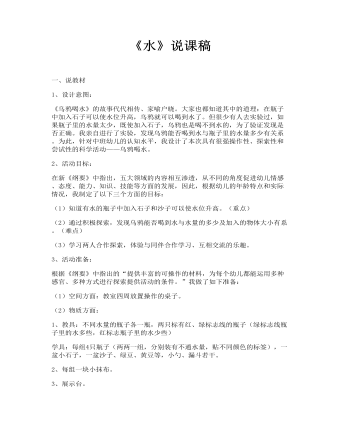
《水》说课稿
2、活动目标:在新《纲要》中指出,五大领域的内容相互渗透,从不同的角度促进幼儿情感、态度、能力、知识、技能等方面的发展,因此,根据幼儿的年龄特点和实际情况,我制定了以下三个方面的目标:(1)知道有水的瓶子中加入石子和沙子可以使水位升高。(重点)(2)通过积极探索,发现乌鸦能否喝到水与水量的多少及加入的物体大小有系。(难点)(3)学习两人合作探索,体验与同伴合作学习、互相交流的乐趣。3、活动准备:根据《纲要》中指出的“提供丰富的可操作的材料,为每个幼儿都能运用多种感官、多种方式进行探索提供活动的条件。”我做了如下准备:(1)空间方面:教室四周放置操作的桌子。(2)物质方面:1、教具:不同水量的瓶子各一瓶,两只标有红、绿标志线的瓶子(绿标志线瓶子里的水多些,红标志瓶子里的水少些)学具:每组4只瓶子(两两一组,分别装有不通水量,贴不同颜色的标签),一盆小石子,一盆沙子、绿豆、黄豆等,小勺、漏斗若干。2、每组一块小抹布。3、展示台。4、fLAsH课件5、乌鸦喝水的故事经验。全方面的准备为活动的成功开展提供了保障。二、说教法在新《纲要》中指出,教师应成为幼儿学习活动的支持者、合作者、引导者,关注幼儿在活动中的表现和反应,敏感地察觉他们的需要,及时以适当的方式应答,形成合作探究式的师生互动。因此,我采用了以下教法:

《墨梅》说课稿
二、说教学目标:1.学会本课生字。2.能正确、流利、有感情地朗读课文,背诵并默写课文。3.了解诗歌的大意,感悟诗人堂堂正正做人,清清白白生活的高尚情怀,领悟本课借物言志的表达方法。三、说教学重点、难点:指导学生有感情地朗读本首诗,感悟诗人堂堂正正做人,清清白白生活的高尚情怀,领悟本课借物言志的表达方法。四、说教学过程:(一)导入新课:同学们,你们读了那么多的书,老师考你们几个课外知识怎么样?1、“岁寒三友”是哪“三友”?2、你能背出有关“岁寒三友”的诗句吗?(指生背)今天,咱们一起来学习、欣赏王冕的千古佳作《墨梅》,读课题。
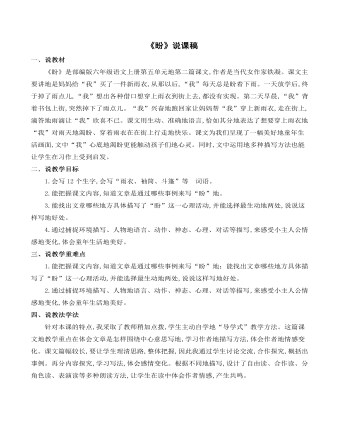
《盼》说课稿
1.会写12个生字,会写“雨衣、袖筒、斗篷”等词语。2.能把握课文内容,知道文章是通过哪些事例来写“盼”地。3.能找出文章哪些地方具体描写了“盼”这一心理活动,并能选择最生动地两处,说说这样写地好处。4.通过捕捉环境描写、人物地语言、动作、神态、心理、对话等描写,来感受小主人公情感地变化,体会童年生活地美好。三、说教学重难点1.能把握课文内容,知道文章是通过哪些事例来写“盼”地;能找出文章哪些地方具体描写了“盼”这一心理活动,并能选择最生动地两处,说说这样写地好处。2.通过捕捉环境描写、人物地语言、动作、神态、心理、对话等描写,来感受小主人公情感地变化,体会童年生活地美好。